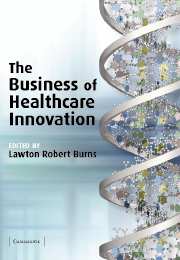Book contents
- Frontmatter
- Contents
- List of figures
- List of contributors
- Preface
- Acknowledgments
- 1 The business of healthcare innovation in the Wharton School curriculum
- Part I The life sciences
- Part II Devices and information technologies
- 6 The medical device sector
- 7 The healthcare information technology sector
- 8 Healthcare innovation across sectors: convergences and divergences
- Index
8 - Healthcare innovation across sectors: convergences and divergences
Published online by Cambridge University Press: 22 September 2009
- Frontmatter
- Contents
- List of figures
- List of contributors
- Preface
- Acknowledgments
- 1 The business of healthcare innovation in the Wharton School curriculum
- Part I The life sciences
- Part II Devices and information technologies
- 6 The medical device sector
- 7 The healthcare information technology sector
- 8 Healthcare innovation across sectors: convergences and divergences
- Index
Summary
The twin towers: invention and adoption
All of the sectors analyzed in this volume face the same dual challenge: the invention of new technology and assuring its long-term clinical adoption by customers. These challenges are neither easy nor inexpensive.
For many of the sectors, the technology and the underlying science have encountered the same phenomenon as other technology development in other endeavors, namely convergence of many skills. Pharmaceutical and biotechnology firms – long accustomed to both random discovery and synthesis of bioactive chemicals or recombination of known active proteins – are now relying on genomic and proteomic foundations for drug discovery. These new sciences are just the first steps in the long process of drug development wherein tools such as bioinformatics must be integrated. As companies in the sector pursue new avenues of discovery and development, and as the associated costs spiral ever upward, healthcare systems throughout the world seek to rationalize care and lower overall costs. The industry has the added burden, therefore, of demonstrating the economic advantages of new drugs, thus giving rise to yet another new discipline, pharmaco-economics.
At the same time, the sectors must increasingly conduct their R&D activities with an understanding of multiple technologies. Pharmaceutical and biotechnology firms must embrace not only genomics and proteomics, but also the more traditional technologies that are chemistry-based. Platform-based firms are constrained to advance beyond their circumscribed technological base to incorporate development and delivery capabilities.
- Type
- Chapter
- Information
- The Business of Healthcare Innovation , pp. 348 - 364Publisher: Cambridge University PressPrint publication year: 2005



